Biorelevant Dissolution Media | FaSSIF & FeSSIF in Drug Development
In pharmaceutical development, FaSSIF and FeSSIF replicate intestinal conditions in fasting and fed states, aiding in predicting drug dissolution, absorption, and bioavailability.
FaSSIF (Fasted State Simulated Intestinal Fluid)
Purpose:
- FaSSIF mimics the composition of intestinal fluids in the fasted state. This medium is used to evaluate how a drug dissolves and behaves when taken on an empty stomach.
Key Characteristics:
- pH: ~6.5 (similar to intestinal pH in the fasted state)
- Ionic Strength: Mimics physiological conditions
- Surfactant Properties: Presence of bile salts and phospholipids enhances solubility for lipophilic drugs
Composition:
- Sodium taurocholate (a bile salt that helps solubilize lipophilic drugs)
- Lecithin (a phospholipid that contributes to micelle formation)
- Sodium chloride (maintains ionic balance)
- Buffer components (sodium hydroxide and acetic acid to adjust pH)
Application:
- Used to assess the dissolution profile of drugs in fasting conditions
- Particularly important for poorly soluble drugs belonging to BCS Class II and IV, where dissolution is the rate-limiting step for absorption
FeSSIF (Fed State Simulated Intestinal Fluid)
Purpose:
- FeSSIF mimics the intestinal environment after a high-fat meal, where the presence of bile salts, lipids, and digestion products can influence drug solubility and absorption.
Key Characteristics:
- pH: ~5.0 (lower than FaSSIF due to acidic gastric emptying after a meal)
- Higher concentration of bile salts and phospholipids compared to FaSSIF
- Presence of fatty acids and digestion products that can enhance solubility for lipophilic drugs
Composition:
- Higher bile salt concentration (compared to FaSSIF)
- Lecithin (phospholipids) for micelle formation
- Additional fatty acids and digestion products
- Sodium chloride (for physiological ionic balance)
- Buffer components (sodium hydroxide, acetic acid) to maintain pH
Application:
- Used to study drug dissolution and solubility in the fed state
- Helps in understanding the food effect on drug absorption
Why Are These Media Important?
Biorelevant Dissolution Testing:
- Traditional dissolution media, such as water or simple buffers, often fail to predict how a drug behaves in the human body. FaSSIF and FeSSIF are designed to closely resemble human intestinal fluids, allowing more accurate in vitro–in vivo correlation (IVIVC).
Food Effect Studies:
- Some drugs dissolve better in FeSSIF (fed state) due to the higher lipid and bile salt content, improving solubility and absorption. Others may show reduced absorption due to increased viscosity or complexation with food components. Studying these effects early in formulation development helps avoid unexpected clinical outcomes.
Read also:
Resource Person: Moinuddin syed. Ph.D, PMP®

